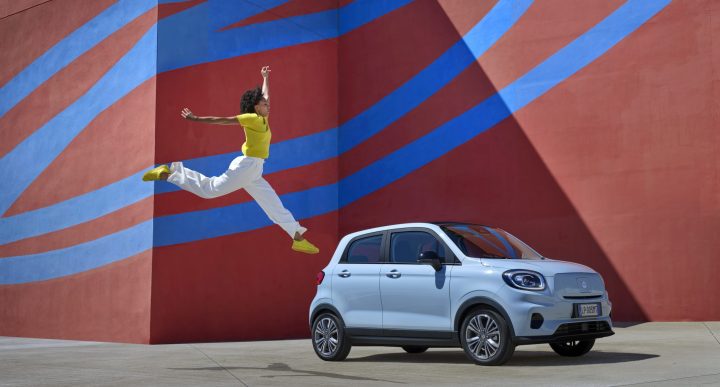The UK new car market is buzzing with electric models at high prices, so it’s worth taking a look at one of the cheapest – the Leapmotor T03.
A Stellantis joint venture with the Chinese company, the car is made in Poland on lines previously producing the Fiat 500, another Stellantis brand, and the Leapmotor models are sold through the more familiar showrooms selling Fiat and Alfa Romeo marques.
 This serves both parents very well, giving the Stellantis dealers a cheaper way into the bargain ev-sector while ensuring Leapmotor have a toe in the European market.
This serves both parents very well, giving the Stellantis dealers a cheaper way into the bargain ev-sector while ensuring Leapmotor have a toe in the European market.
How this will ultimately affect Stellantis’ entry-level Dacia ev range remains to be seen, but the competition must be good for buyers anyway.
Leapmotor cut £1,500 from the T03 launch price after it was excluded from the deal in the Budget this Spring which favoured non-Chinese ev-models, so Leapmotor T03 remains highly competitive and is one of the cheapest zero emissions cars currently on sale in Britain.
 While it’s cheap, it’s not nasty and comes with satellite navigation, adaptive cruise control, sunroof, auto climate control, 10.1-inch infotainment touchscreen and powered windows as well as heated powered door mirrors.
While it’s cheap, it’s not nasty and comes with satellite navigation, adaptive cruise control, sunroof, auto climate control, 10.1-inch infotainment touchscreen and powered windows as well as heated powered door mirrors.
There are also three driving modes, eco, normal and sport to please drivers’ styles available to maximise the modest battery and motor.
Once seated you simply select direction of travel, depress the throttle and you’re away at a somewhat sedate pace. Eco mode is very unentertaining but maximises range, normal is slightly brisker while Sport is the most enjoyable but visibly drains the range.
Our indicated 165 miles dropped once we were on busy country roads and it was tempting to ease back into Eco mode in traffic.
 It kept up quite well with the traffic and that included a short spell of dual carriageway but you have to very carefully judge overtaking or it might run out of urge at the wrong moment.
It kept up quite well with the traffic and that included a short spell of dual carriageway but you have to very carefully judge overtaking or it might run out of urge at the wrong moment.
It’s always a good idea to read the road as far ahead as possible, plan your acceleration, overtaking and braking while anticipating how sharp a corner might be.
The Leapmotor T03 makes no pretense at being a sporty hatchback and it not only seemed to roll-around bends but also dipped under acceleration and braking like an old Citroen 2CV and its ride was firm, even bumpy over some surfaces.
 The front wheels generally behaved themselves, but in the Sport setting the did sometimes scramble to grip and I am not sure what it would be like on wintry surfaces.
The front wheels generally behaved themselves, but in the Sport setting the did sometimes scramble to grip and I am not sure what it would be like on wintry surfaces.
Secondary controls were mostly accessed through the column stalks or hidden somewhere in the touchscreen while the basic gauges infront of the driver were poorly marked and illuminated.
Heating and ventilation did its job directing air but seemed to lack strong output to the rear of the car so a family would be grateful for the four powered windows.
 The door openings were small, particularly into the back seats and the tailgate hid a small luggage area suitable for only a couple of shopping bags, not a weekend suitcase for two or more. Oddments provision was also poor.
The door openings were small, particularly into the back seats and the tailgate hid a small luggage area suitable for only a couple of shopping bags, not a weekend suitcase for two or more. Oddments provision was also poor.
The legroom was very tight in the back and more than two average sized people would struggle for shoulder room as well. The pair of front seats had more space and slightly better adjustment room but none of them were comfortably padded for longer journeys.
Visibility was good with slim roof pillars, useful washers and wipers, low waistline and reversing sensors and camera.
 Parking was easy thanks to the clear sightlines, good steering and sensors, not to mention the compact size of the Leapmotor T03.
Parking was easy thanks to the clear sightlines, good steering and sensors, not to mention the compact size of the Leapmotor T03.
For a commuter car it does a reasonable job so long as you don’t have to travel too far between recharges and have reasonably good roads to use.
Although fairly well equipped for modern motorists, the size and dynamic ability of the Leapmotor T03 reminded me of a family car from the 1960s but given a more streamlined style and hefty price difference.
However, if you take a typical 1960s car cost about £500, then in today’s terms that is almost identical to the Leapmotor T03 at £14,500.
So times can move on and then stay the same.

